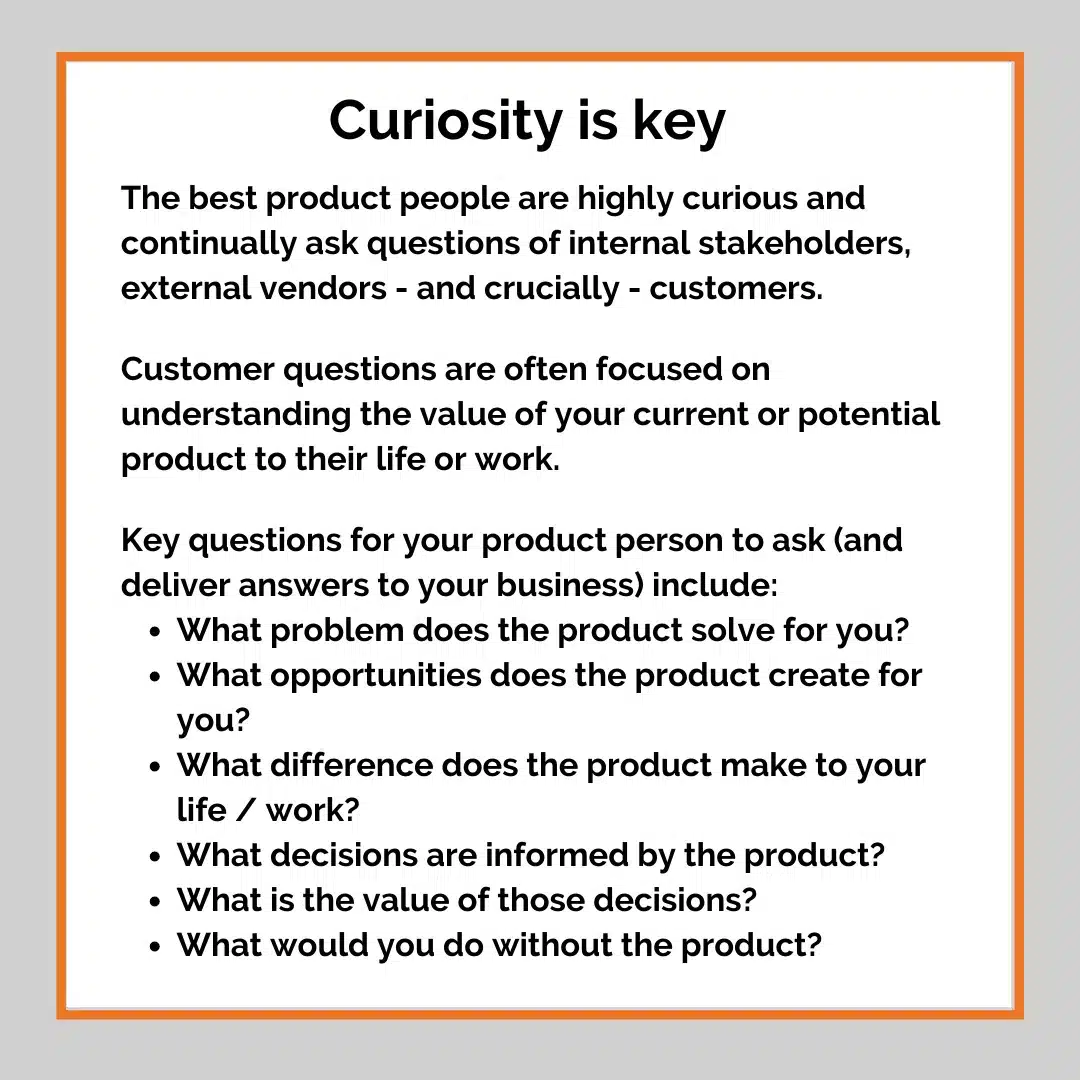While established digital media businesses increasingly have the ‘product’ function firmly embedded into their structure, media entrepreneurs can be cautious when it comes to hiring a product person, in large part due to uncertainty about the role: what sort of person they need and what that person does day-to-day. We explain who you need and just some of what they’ll do.
Who they are not
In considering whether to hire a product person to your growing media business, it’s important to be clear on who they are and who they are not.
It’s easier to start with who they are not. They are not IT. And neither are they sales, marketing or content people who already have a full-time job to perform. As talented as your team may be, product management cannot be tackled successfully as a peripheral part of a role or team. And product usually needs a set of skills that may not already exist within the business.
Product people within media can come from a range of commercial and content backgrounds, however. There is no single path, but product people typically have a core set of attributes that you need to keep front of mind when hiring a product person.
Who they are
Your product person should be tech-savvy and fluent in analytics. They need to be confident project managers, able to knit together a wide range of dependencies and demands. And their superpower should be the ability to communicate up, down and across the business to inform and express the product vision and its outcomes to all internal and external stakeholders responsible for it becoming a reality. This is especially true given product people may have few – or no – direct reports (especially in small businesses) and have to get things done through the power of influence.
Product success is a carefully orchestrated democratic process and a strong lead instinctively knows how to cajole and include teams in the elements that play to their strengths or will benefit from their influence, rather than dictate a top-down roadmap or allow everyone to have an equal voice in everything. Both extremes lead to chaos, conflict or total standstill.
In addition, product needs to be given a degree of time and authority that matches the impact of the outcomes expected from your product, especially any new product development (which typically means high spend and ambitious targets). Commercial success will not come from product development that is compromised by lack of commitment and unclear ownership. Bear this in mind when hiring your product person. They need to be given the scope and seniority to own the product function.
A connected and central function
This is not to say that product thinking is siloed. The opposite is true. It should pull in all the necessary experience and skills from around the business to inform decisions and to ensure product development is underpinned by realism rather than wishful thinking.
A disconnected product management process will fall down because it is likely to be informed by assumption rather than truth, especially regarding the availability of capacity or capabilities upon which success is contingent. Product development plans based on assumptions are based on false hope of what is possible from the business, making successful execution extremely unlikely.
For example, if your new product has the requirement for daily, highly timely content this is unlikely to be delivered by a business built around a monthly publication rhythm. Or, a marketing services business will not naturally grow from a print advertising sales team. Your product person needs to identify what is possible from your business and get the buy-in from the relevant contributors to deliver that.

Tech-friendly, but not quite ‘techie’
How technical your product person needs to be will depend on how technical your business is. If you’re a digital media business, they will need to be pretty tech-savvy. If you’re an events business, maybe less so. Although hybrid and virtual events have increased the need for tech-savviness from events product managers.
Product thinking examines customer behaviours and end-to-end journeys and centres on the improvement of workflows, removal of blockers and meeting of unmet needs. This requires an analytical mind that is comfortable scoping and researching the technology solution required to improve the customer experience. It’s important for your product person to have sufficient knowledge about the technology required to fulfil product requirements, to find the right solutions and support.
Digital user journeys are more often than not reliant upon a selection or ‘stack’ of technology. A fragmented and unintegrated stack fails the user and wastes valuable business resources in shifting and sifting data. But getting our tech stack right isn’t easy. Settling on the wrong solution can be costly and disheartening and seriously impede the growth of your business. Being wedded to a single software island that promises an all-in-one solution sounds great but can be restrictive. Typically, a growing media business needs the freedom to ‘casually date’ technology and not be married to any single solution. It needs to be able to switch out a function or component of its stack as needs change or new ones are discovered. These decisions need to be made dynamically and iteratively, without a costly and disruptive divorce, and carefully managed by your product person.
Someone who decodes the coders
Tech-savviness is also vital in the role your product person should play as the translator between ‘the business’ and the internal or external developers working on your product. Even the best development firm or superstar coder can be thrown off-course by lack of clear communication from their internal or external ‘customer’. Someone who speaks the language of developers and can translate that back to the business while interpreting business need into build requirements is a vital investment in making the most of your development spend.
At home with data
Product people should be driven by analytics, robust research and evidence rather than anecdotal feedback, assumptions, legacy truths or internal ‘myths’ about your product. Usage data always tells a compelling story: engagement metrics act as the ultimate guide to customer value and keep a check on emotionally-driven decisions based on untested hypotheses. Your product person should feel comfortable with gathering and interpreting this data and using it to prioritise your product activity.
A product manager not (just) a developer
"Be stubborn on vision, but flexible on details."
Jeff Bezos
It is important to note that product thinking is not just – or even mainly – about product development but about product management. There is of course a point in time at which a new product is ready to go-to market and meet its customers but it should never be considered ‘finished’. This reinforces the need for a product person. While existing staff or freelancers might get to you to the point of a new product launch, they are highly unlikely to be able to manage the product day-in-day-out.
This is especially true given a product built using Agile methodologies has likely evolved considerably from the scope set out at the planning stage. And while the essence of that scope – as captured in effective user stories – should hold up, the route to delivery may have altered through discovery and testing processes. Perhaps an initially unknown user requirement was discovered in testing that strongly enhances the product value proposition? An Agile product development process should allow you to accommodate this opportunity to add customer value.
There are three success factors for a product development project. Was it done on time, to budget and within scope? You can – and will often – choose to forgo one for the sake of another. On-time and / or on-budget projects often mean you will have not delivered every requirement you initially planned for your new product, and you will therefore have the startings of a roadmap for what to do next.
What’s more, you can guarantee that once user meets product, that set of requirements will grow quickly, particularly with the speed at which user expectations now change. Product thinking continually captures and reprioritises development work, based on the impact it will deliver vs. the effort (and cost) involved. Ongoing ownership and management of this process is a full-time job. Hence the need for a product person.
So, product is a big and important role. Those media businesses that have taken the plunge and invested in product quickly find that they couldn’t imagine working without their product person. Ask yourself: what value could a product person bring to your business?
Want to establish a product function in your business? Ask us about Collingwood’s Product Management 101 programme.
Want more product insight? Watch our Product Thinking webinar to learn from some of media’s best product people – Collingwood welcomed Sally Foote, VP of eCommerce at GoCompare and Laura Jenner the Director of Product Management & UX at GlobalData Media to share ideas with our own CPO, Jenefer Thoroughgood and Practice Lead for B2B Information Andy Baker.




